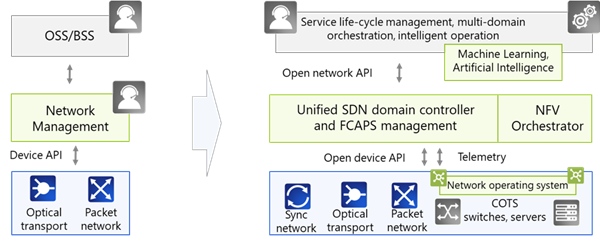In recent years, SDN and NFV have matured from technologies with potential into mandatory requirements for agile, fast and cost-efficient production of communication services. We’re now seeing widespread deployment with communication service providers (CSPs) implementing ambitious digitization projects. Many CSPs are combining this with a transition towards full automation and even autonomous operations, while also minimizing the amount of proprietary hardware. Standard hardware components in combination with network operating systems and software appliances will form the networks of the future.
Those are very ambitious targets not only requiring a re-architecting of the network but also a re-design of operational practices. Such a transition will take time, as existing networks need to migrate from today’s hardware-centric design towards open, COTS-based solutions empowered by agile and flexible software for control as well as virtual network functions.
A seamless network evolution should be implemented stepwise, targeting different network and technology domains:
- Today’s management systems are optimized for manual operations with powerful user interfaces. While this operational practice will be applied for years, there needs to be additional means to control networks through open interfaces from end-to-end orchestrators for automated service activation and service assurance
- Hardware-defined network functions need to be virtualized through software appliances on COTS servers as well as network operating systems on bare metal switches. While both technologies are applied in data centers today, additional requirements for widespread deployment in geographically dispersed public networks need to be met
- As the complexity of networks increases and cloud-based services change rapidly, data analytics and network intelligence need to complement human reasoning. Deep learning algorithms will free operational teams from complex tasks, even taking into consideration a much broader data base
We at ADVA have been focusing on the different skills required to ensure a seamless migration towards automated and finally autonomous operations. Our NFV solutions were commercially deployed as early as 2015, and our competence and experience have developed further since then. Today, we are among the very few companies enabling NFV in operator networks. Similarly, with SDN, we showcased the value of this technology for automating service activation for high-bandwidth media services back in 2015. Today, open SDN control interfaces are part of our management offering and are also integrated with many of our products. What’s more, we’re also now proving the value of artificial intelligence with use cases such as predictive maintenance or performance analysis for network quality parameters.

In the next step, we're combining those competences and experiences into a framework of software solutions, consolidating and expanding the capability of our present network management system, adding new software solutions in combination with white box services, and opening up for the implementation of automated and intelligent control with standard SDN interfaces.
Even these first steps on the journey towards automated operations are creating value for our customers. We're eager to see the impact on operational efficiency as well as a rapid uptake of new service offerings.
